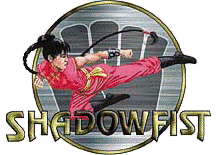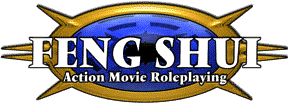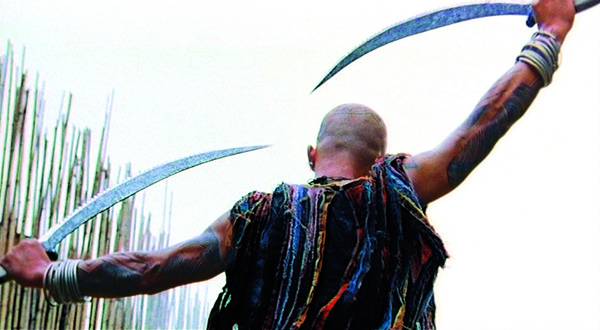
Way back when Magic: The Gathering was first released, a number of other companies were quick to capitalize the financial opportunities evident in the realm of collectible card games (i.e. CCGs). One such company was Dædalus Entertainment and their CCG offering of Shadowfist, a riotous attempt to simulate the high-energy action evident in the world of Hong Kong cinema. It blended together ancient martial arts masters, modern Hong Kong Triad gangsters and police officers, spell-tossing sorcerers, supernatural monsters, and bizarre near-future cyborgs in a secret war for world domination. Shadowfist also had some of the best cards around, with such names as: "Back for Seconds," "Mooks" (text: Stupid brutal punks are something the world never seems to run out of.), "Dragonfighter" (text: The last honest guy in the wrong part of town.), "Student of the Bear (the character pictured is swinging around a parking meter), "Now You've Made Us Mad," "Really Big Gun," "Grenade Launcher" (text: Grenades are much more effective in the movies than in real life. This ain't real life.), "Bag Full of Guns," "Too Much Monkey Business" (with about a zillion chimps pointing guns at the viewer), and "Masked Avenger" (text: Criminals are grass and she's the lawn mower.).
Soon after Shadowfist appeared, Dædalus Entertainment released Feng Shui, a role playing game based on the world described in the Shadowfist CCG. As with Shadowfist, Feng Shui was a game that didn't take itself too seriously (one adventure contains the following GM advice: “What to do if the PCs fold faster than Superman on laundry day.”) Feng Shui was also one of the few RPGs that managed to live up to its billing. The game simulated high-speed Hong Kong action and did it beautifully. It was a bare bones system, concerned more with fast and breathtaking action as opposed to overly detailed rules concerning character generation, combat or skill use.
With regards to the HERO System, Feng Shui has a lot to offer. The setting is interesting and offers a wide range of adventure ideas, character concepts, and powers, while the cross-time Secret War is perfect for HERO's ability to simulate just about any type of setting and/or genre. Several of the supplements, especially Back for Seconds and Blowing Up Hong Kong, are stuffed with NPCs, monsters, enemies, gadgets, and locations just begging to be adapted and used in virtually any type of campaign. Unfortunately, Dædalus Entertainment has gone out of business and the future of Feng Shui is very much in question.

[Writer's note: Feng Shui is now published by Atlas Games and its future is fairly secure. In addition, Shadowfist is once again back in production.]
[Writer's additional note: Feng Shui is still published by Atlas Games but they are no longer developing new material for it.]
Anyway, back to my article.
Among the many things presented in the Feng Shui rulebook, is a section on "Fu Schticks". One possible characteristic for Feng Shui characters is "Kung Fu," or just "Fu." Fu is derived from "Chi" (Chi being another game characteristic). Chi represents how in tune a character is with the mystical life energies of the Earth. Fu measures an individual's inner power and is used to fuel amazing Kung Fu powers and stunts. Naturally, someone with a great deal of inner Fu is said to have "powerful kung fu," a quote used countless times in countless Asian martial arts films.
Characters with Fu can use Fu Schticks, by selecting desired powers (or "schticks") from any one of a number of paths. These paths allow a character to simulate the wilder powers seen in many Hong Kong films. This includes leaping great distances, throwing a blinding series of blows, shattering walls with a touch, running up walls and so on (as a side note, these movies are known in Hong Kong as wuxia films—see HERO System Martial Arts or Ninja Hero 5th Edition for more). Many of the powers in these assorted Fu Paths have great names just begging to be used as powers in a wild martial arts game, so....
Taking the name of the power, as well as the description for what the power does in Feng Shui, I’ve translated the the assorted schticks into HERO System terms. Let me point out that not all of the schticks have been adapted, as several just don't translate. In addition, many of the schticks given below duplicate each other, an unavoidable side effect of trying to define the basic effect of many of the Feng Shui schticks. In general I tried to stick to a base of 60 Active Points for the schticks, although some go over, and many are far less. The Active Point value of different powers are given as guidelines only, GMs should feel free to alter them to fit campaign guidelines. Additional comments will be included with each Path and individual schtick.
To fully reflect the nature of Feng Shui fu schticks, GMs might want to consider applying the Limitation Requires A Roll. The Required Roll would be Power Skill : Ch’i-Centering (or something like that) and is figured as follows: 9+ (EGO/5).
There were two Paths I left out entirely. The first was the Path of the Immutable Clay, with such schticks as Clearing the Ground, Creative Thunder, No Medicine, Unexpected Harvest, and The Wandering Cow. These schticks involved dealing with "arcanowave powers" and are too game specific to be generalized for inclusion here. The second was the Path of the Tightening Coils, with such schticks as Coil of the Snake, Eyes of the Snake, Lunge of the Snake, Slither of the Snake, and Strike of the Snake. This Path concerned itself with allowing the character to (in effect) manipulate the Feng Shui "Speed Chart," something I felt was quite impossible to translate to HERO System terms.
Purchasing Fu Schticks
In Feng Shui you buy schticks in paths. In other worlds, buying schtick A allows you to buy schtick B, and so on. In some cases, a path will fork, allowing characters to expand their fu in different directions. In addition, some schticks require the character to have bought two other schticks. With regards to this article, I’ve abandoned this. The schticks are listed in alphabetical order, first by Path, then by individual schtick. Game Masters may require PCs to buy only from one path, or only buy from specific paths, or buy from paths that reflect the specific martial art they know (thus keeping a master of Muay Thai from purchasing the Path of the Passive Wings.)
Fu Schtick Presentation
All Fu Schticks are presented using the same standard template seen in numerous HERO System products. The notation should be self-explanatory, see the Martial Arts Power section of HERO System Martial Arts for more information. All Schticks include a Skill Roll Penalty, even if the power doesn’t need a Skill Roll, so characters can preform them as a one-shot “martial arts trick” if they ever need to.
A Note On Requires A Roll: Many Schticks have the Limitation of Requires A Roll and the note of +1 (value) for every 2 points Rolls is made by. When a character uses a Schtick with a Required Roll, he simply rolls the dice and compares the result to the specified Skill (or Characteristics). No Skill Roll Penalty is applied, the character simply gains bonuses based on how well he made the roll by. Game Masters may rule that buying the Requires A Roll at -1 per 5 Active Points means the character only gains +1 (value) for very 4 points the Roll is made by, while -1 per 20 Active Points means the character gains +1 per point the roll is made by (see King on the Water for an example of this).
- Path Of The Brilliant Flame
- Path Of The Broken Island
- Path Of The Clever Eye
- Path Of The Empty Bottle
- Path Of Flying Steel
- Path Of The Hands Of Light
- Path Of The Healthy Tiger
- Path Of The Leaping Monkey
- Path Of The Leaping Storm
- Path Of The Passive Wings
- Path Of The Preying Mantis
- Path Of The Raging Bear
- Path Of The Selective Master
- Path Of The Shadow's Companion
- Path Of The Sharpened Scales
- Path Of The Storm Turtle
- Path Of Visible Resonance

A PDF file containing all of the fu schticks.